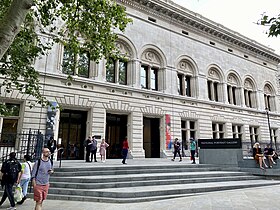File:Henry Wriothesley, 3rd Earl of Southampton (3772864875).jpg

Original file (416 × 700 pixels, file size: 123 KB, MIME type: image/jpeg)
Captions
Captions
Summary
[edit]| anonymous: Henry Wriothesley, 3rd Earl of Southampton
|
|||||||||||||||||||||||||||
|---|---|---|---|---|---|---|---|---|---|---|---|---|---|---|---|---|---|---|---|---|---|---|---|---|---|---|---|
| Artist |
Unknown artist
|
||||||||||||||||||||||||||
| Title |
Henry Wriothesley, 3rd Earl of Southampton label QS:Len,"Henry Wriothesley, 3rd Earl of Southampton" |
||||||||||||||||||||||||||
| Object type |
painting |
||||||||||||||||||||||||||
| Genre |
portrait |
||||||||||||||||||||||||||
| Description |
|
||||||||||||||||||||||||||
| Depicted people |
Henry Wriothesley, 3rd Earl of Southampton |
||||||||||||||||||||||||||
| Date |
circa |
||||||||||||||||||||||||||
| Medium |
oil on canvas |
||||||||||||||||||||||||||
| Dimensions |
height: 204.5 cm (80.5 in) dimensions QS:P2048,+204.5U174728 dimensions QS:P2049,+121.9U174728 |
||||||||||||||||||||||||||
| Collection |
Private collection institution QS:P195,Q768717 ; on loan to the
institution QS:P195,Q238587 |
||||||||||||||||||||||||||
| Accession number |
NPG L114 (National Portrait Gallery) |
||||||||||||||||||||||||||
| Object history | Lent by a private collection, 1964 | ||||||||||||||||||||||||||
| References | |||||||||||||||||||||||||||
| Source/Photographer | Henry Wriothesley, 3rd Earl of Southampton- Uploaded by LongLiveRock, 30 July 2009 - Author: Lisby from Western Maryland, United States | ||||||||||||||||||||||||||
Licensing
[edit]|
This is a faithful photographic reproduction of an original two-dimensional work of art. The work of art itself is in the public domain for the following reason:
This digital reproduction has been released under the following licenses: This file is licensed under the Creative Commons Attribution 2.0 Generic license.
In many jurisdictions, faithful reproductions of two-dimensional public domain works of art are not copyrightable. The Wikimedia Foundation's position is that these works are not copyrightable in the United States (see Commons:Reuse of PD-Art photographs). In these jurisdictions, this work is actually in the public domain and the requirements of the digital reproduction's license are not compulsory. |
| This image, originally posted to Flickr, was reviewed on 12 October 2012 by the administrator or reviewer File Upload Bot (Magnus Manske), who confirmed that it was available on Flickr under the stated license on that date. |
File history
Click on a date/time to view the file as it appeared at that time.
| Date/Time | Thumbnail | Dimensions | User | Comment | |
|---|---|---|---|---|---|
| current | 16:38, 12 October 2012 | 416 × 700 (123 KB) | File Upload Bot (Magnus Manske) (talk | contribs) | Transferred from Flickr by User:LongLiveRock using flickr2commons |
You cannot overwrite this file.
File usage on Commons
The following 2 pages use this file:
File usage on other wikis
The following other wikis use this file:
- Usage on ja.wikipedia.org

